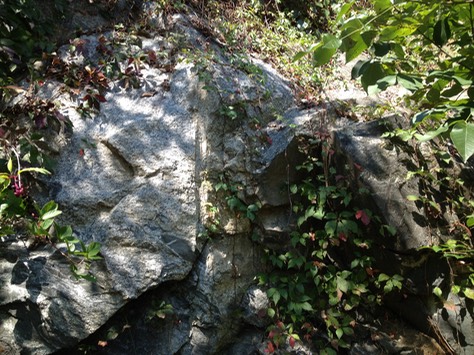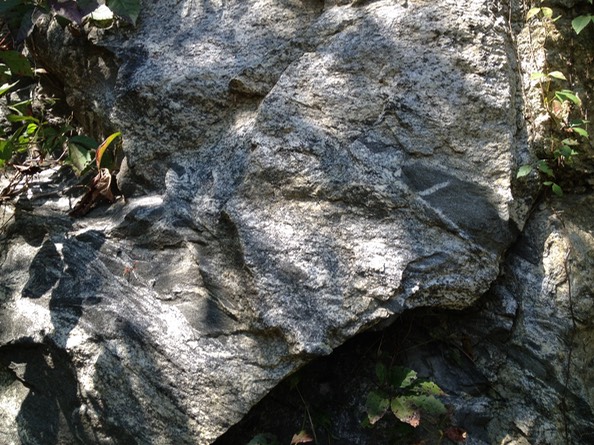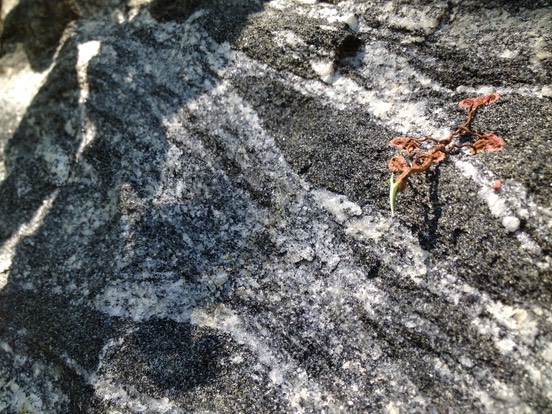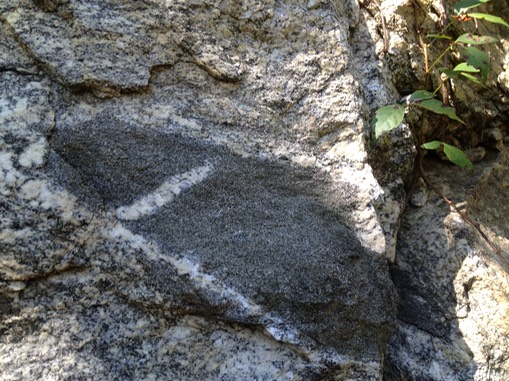Stop 1
Our first stop was to the back (yes, behind the dumpster) of the Food Lion in Leatherwood, at the corner of US-58 and VA-57. Click here to see a gigapan of the site! You can zoom in and see AMAZING detail.

As we approached the outcrop the first questions were:
1) How many different rocks are there? One, two, three, or more?
2) What type or types of rock do we see? What do you observe to let you know this?
3) Explore the gigapan and look at the snapshot by sciencegal for additional probing questions.
Hopefully you can see that the right side appears darker than the left side. This is a real observation, and not just shadowing from the overgrowth of vegetation. It's a little hard to see, so let's get closer. So, how many types of rock to you see?

Now you notice within the lighter color rock there are pieces of the darker color rock within it. Hmm, that will be important later on, so remember that.
Now, do you notice anything that will either definitely rule out a rock type or allow you to determine which one you are observing?
Let's get a bit closer.

An important distinction to notice is whether you are oberving crystals or grains. Hopefully you saw that there was no clear bedding or layering (so possibly not sedimentary).
Now, up close, do you see discrete crystals or grains? If so, which one? Do you see them in the light rock, the dark rock, or both?
You probably noticed that you could in fact see crystals in both rocks. (These were not individual grains like sand or pebbles, they were shiny crystals.) So, we are looking at either an igneous or metamorphic rock. There was no foliation, but, unfortunately, that doesn't rule out metamorphic rocks. What we did notice, though I couldn't capture it well with all of the trees and Virginia Creeper in the way, was that there was an area of dark rock and an area of light rock and a "swirly mess" with both rocks. This is not typical of a metamorphic rock, but seemed like it could be where two igneous rocks met while they were still partially molten. This is, in fact, the case.
SO, the next questions are to tell the composition, texture, and origin of each rock. That you can do from the pictures above.
Finally, we want to establish relative ages of each of these rocks. Remember that area above I told you not to forget? Let's look more closely at that.

Think back to what we call pieces of one rock stuck up in another.
That's called an inclusion, and they are significant in determining relative age.
There's more! Within the inclusion, there is a "finger" of the lighter rock squirting up into the darker inclusion. That is an intrusion, and it is also significant for determining relative age.
Inclusions are OLDER than the rock in which they are included. Intrusions are YOUNGER than the rock into which they intrude.
So at this point, you should be able to tell: 1) how many rocks there are, 2) what types of rock they are, 3) the descriptive information about the rocks, and 4) the relative ages of the rocks.
As a side note, rocks are named for the location in which they are first found. The lighter color rock is called the Leatherwood Granite, and the darker rock is called the Rich Acres Gabbro.
Now, on to STOP 2.